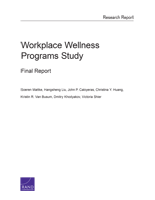| 来源类型 | Research Reports
|
| 规范类型 | 报告
|
| ISBN | 9780833080738
|
| 来源ID | RR-254-DOL
|
| Workplace Wellness Programs Study: Final Report |
| Soeren Mattke; Harry H. Liu; John P. Caloyeras; Christina Y. Huang; Kristin R. Van Busum; Dmitry Khodyakov; Victoria Shier
|
| 发表日期 | 2013
|
| 出版年 | 2013
|
| 页码 | 170
|
| 语种 | 英语
|
| 结论 |
Characteristics and Prevalence - Approximately half of U.S. employers offer wellness promotion initiatives, and larger employers are more likely to have more complex programs.
- Programs often include wellness screening activities to identify health risks and interventions to reduce risks and promote healthy lifestyles.
Impact- Employee uptake of worksite wellness programs remains limited. Fewer than half of employees (46 percent) in the firms surveyed undergo clinical screening or complete a health risk assessment (HRA), which is used to identify employees for interventions.
- We found statistically significant and clinically meaningful improvements among program participants in exercise frequency, smoking behavior, and weight control, but not cholesterol control.
- Participation in a wellness program over five years is associated with lower health care costs and decreasing health care use. The average annual difference is an estimated $157, but the change is not statistically significant.
The Role of Financial Incentives- Incentives for completing an HRA are effective, particularly above a threshold of $50. On average, an increase in the HRA incentive by $10 is associated with a 1.6 percentage point increase in the HRA completion rate for incentives in the range of $0-$100.
- Smoking cessation is also the only health behavior for which achieving the goal earned a greater reward than participating in a program.
- "High-powered" incentives that tie as much as 20% of the cost of coverage to achieving a health goal remain rare.
Key Facilitators- Broad outreach and clear messaging from organizational leaders.
- Making wellness activities convenient and accessible for all employees.
- Making wellness an organizational priority among senior leaders.
- Leveraging existing resources and building relationships with health plans to expand offerings at little to no cost.
- Approaching wellness with a continuous quality improvement attitude, and solicit feedback from employees to improve programs.
|
| 主题 | Chronic Diseases and Conditions
; Health and Wellness Promotion
; Health Behaviors
; Health Care Costs
; Health Insurance
; Workforce Management
; Workplace Wellness Programs
|
| URL | https://www.rand.org/pubs/research_reports/RR254.html
|
| 来源智库 | RAND Corporation (United States)
|
| 资源类型 | 智库出版物
|
| 条目标识符 | http://119.78.100.153/handle/2XGU8XDN/107534
|
推荐引用方式
GB/T 7714 |
Soeren Mattke,Harry H. Liu,John P. Caloyeras,et al. Workplace Wellness Programs Study: Final Report. 2013.
|
|
文件名:
|
1397824215374.gif
|
|
格式:
|
GIF
|

|
文件名:
|
RAND_RR254.pdf
|
|
格式:
|
Adobe PDF
|
除非特别说明,本系统中所有内容都受版权保护,并保留所有权利。